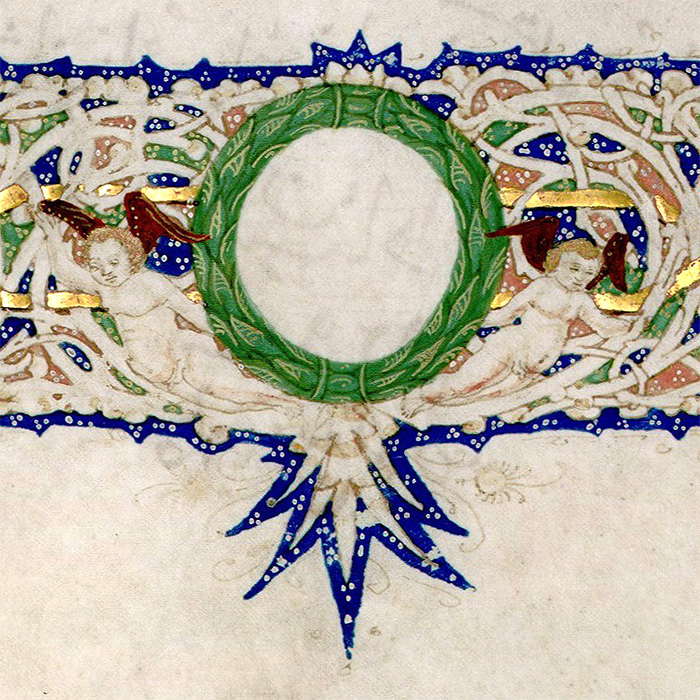Panegyrici Latini XII
The codex contains the famous collection of imperial panegyrics.
1r-42r Incipit panegyricus Plinii Secundi dictus Traiano imperatori
42r-62v Incipit panegiricus latini Pacati dictus Theodosio
62v-74v Incipit Gratiarum actio Mamertini de consulatu suo Iuliano imperatore
74v-88v Incipit panegyricus Nazarii dictus Constantino imperatori
88v-143r Incipiunt panegirici diversarum Manerierum
89r-94v Si Flavia Eduorum tandem
94v-103v Incipit secundus coram Constantino dictus
103v-108v Incipit tertius coram Maximiano et Constantino imperatori
108v-115v Incipit quartus Constantino dictus
115v-122r Incipit quintus [panegyricus Eumenii pro instaurandis scholis]
122r-127v Incipit sextus
127v-134r Item eiusdem magistri Mamertini genethliacus Maximiani Augusti
134r-143r Hic dictus est Constantino filio Constantii
The field dedicated to the coat of arms on the title page remains blank. The fact that the codex was taken to Istanbul and the guilded chased edges of the codex implies that the volume belonged to the royal library in Buda. János Csontosi classifies this codex to the “probable Corvinas” (Csontosi 1877, 184–185). Edith Hoffmann and Ilona Berkovits do not consider this volume a Corvina. Csaba Csapodi does not classified the volume as an authentic Corvina (Csapodi 1973, Nr. 931) but later he accepted the codex’ identification as a Corvina (Csapodi 1990, Nr. 17). Edit Madas lists among the authentic Corvinas but with a question mark (Madas 2009, Nr. 152).
The assemblage of the double leaves is false at a certain point. Gathering 13 (ff. 121–130) consists of five double leaves the two central ones of which were bound in the wrong order. The mistake seems to have taken place when the codex was made up. From f. 63 on, another modern hand corrects the mistakes of the previous modern hand. For this reason, some leaves have double foliation when the first hand needed to be corrected. Of the two foliation, the later one (smaller in size) is to be followed.
The margins wear the traces of more coeval users’ hands.
The text of the manuscript was analysed with philological perspectives by Jenő Ábel (Ábel 1879, 78–84).
Dethier observed and described that the codex had leather binding (Dethier, Inventory 1, Nr. 6). His observation is confirmed by the edges characteristic of the Corvina leather bindings as well as the brown traces in the margins of the former pastedowns.
One of the flyleaves (f. IIv) carries a nineteenth-century identification mark, made probably in the Saraı: No 15.
The codex was taken from Buda to Istanbul probably in 1526 and donated to the Youth of the University of Budapest in 1877 by the Ottoman emperor, Abdul Hamid II. The present leather binding was prepared for this occasion in Istanbul. The dedication is copied in Turkish and in golden ink on ff. 1v–2r, which says – based on Béla Erődi’s Hungarian translation – as follows: This codex is from among the books that were kept in the imperial library Topkapı since the time his Majesty, the legislator Chan Suleiman the Magnificent – Donated by the Padishah of the Ottoman Empire, his Majesty II. Abdülhamid to the University of Hungary. 1294. rebiü’l-evvel 25th [9th April 1877].
The ff. 1–4 are difficult or impossible to read because the parchment was infected. The codex was restored by Ágnes Horváth in the Conservation Laboratory of the National Széchényi Library in 1987.
Abberviated Bibliography: Dethier; Csontosi 1877, 157–218; Ábel 1879, 78–84; Mezey 1961, Nr. 12; Csapodi 1973, Nr. 931; Csapodi 1990, Nr. 17; Erődi 2001; Tóth 2008, Nr. 12; Bibor 2008, Nr. 25 (Wehli Tünde); Madas 2009, Nr. 152.
(Edina Zsupán)
DATA SHEET
Shelfmark: Cod. Lat. 12.Country: Hungary
City: Budapest
Keeper location: University Library, Eötvös Loránd University
Content: Panegyrici Latini
Writing medium: parchment
Number of sheets: II + 143 + II* fol.
Sheet size: 257 × 165 mm
Place of writing: Florence
Date of writing: 1450–1470
Scriptor: not identified; (script: humanistica cursiva)
Illuminator: not identified; title page with white stem motives (bianchi girari); initials: ff. 1r, 42r, 62v, 74v, 89r, 94v, 103v, 108v, 115v, 122r, 128r, 134v
Place of illumination: Florence
Date of illumination: 1450–1470
Crest: the field dedicated to the coat is left blank
Possessor, provenience: unidentified Hungarian owner (?); King Matthias Hunyadi; Ottoman sultans; it was returned to Hungary as a present of Abdul Hamid, Sultan of the Ottoman Empire in 1877.
Binding: 19th-century, paper board, red Turkish leather binding
Language of corvina: Latin
Condition: Restored (NSZL, Ágnes Kálmán-Horváth, 1987)
